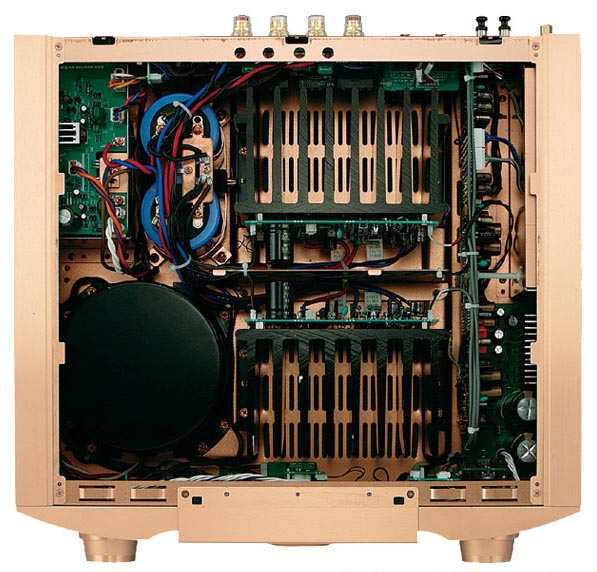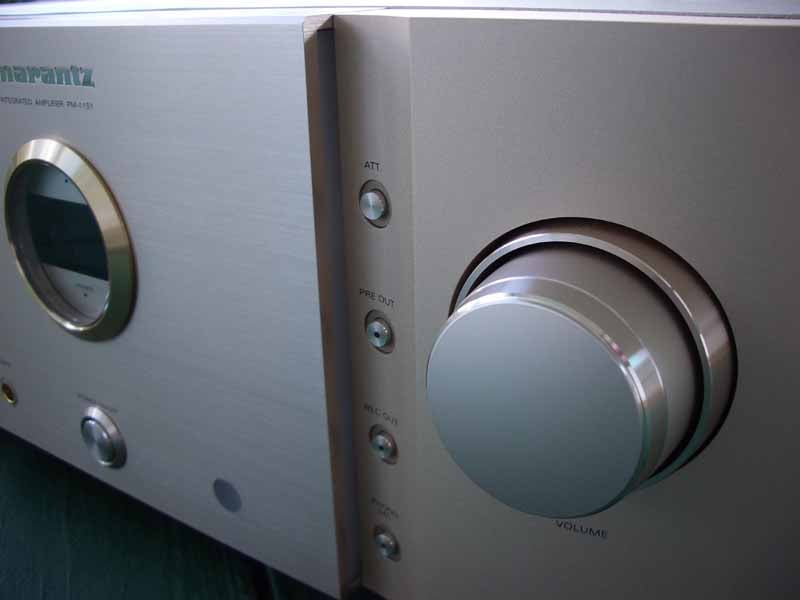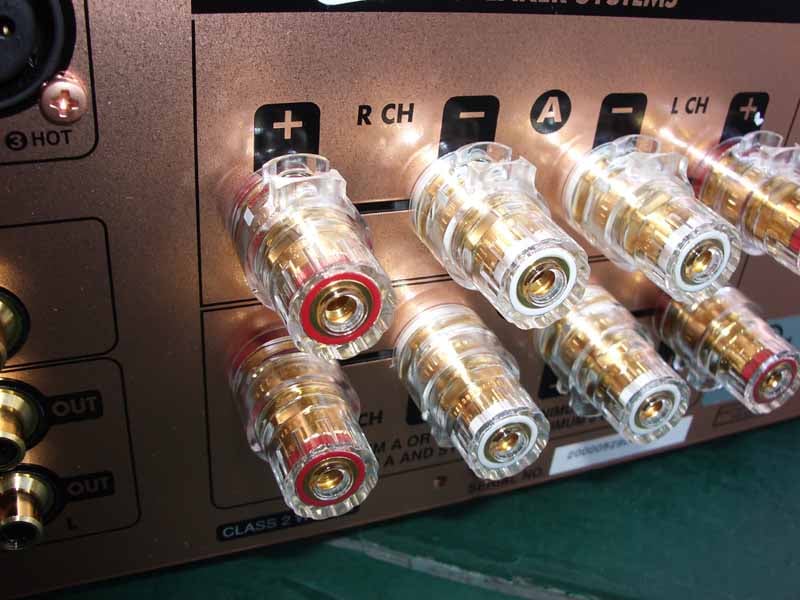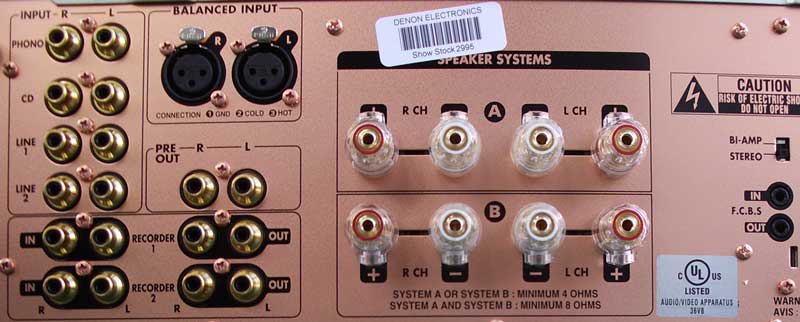Marantz PM-11S1 Integrated Amplifier Review
I drive a simple vehicle. It's a 2003 Jeep Liberty and I like it a lot. If I were offered the opportunity, however, to test drive a Hummer or Porsche Carrera - I'd do it in a heartbeat. Why? Because I'm not likely to fork out that kind of money in my lifetime and it's occasionally nice to see "how the other guy lives". The Marantz PM-11S1 is my Porsche Carrera this month. At a price tag of over $4k I'm not going to be able to afford to keep this baby in my reference system for long, but it is a superb machine with all the styling of a European sports car. It's the kind of product you don't want to leave fingerprints on and will find yourself taking extra time to install it into your system - not because it can't be manhandled or take the abuse, but because - like a fine work of art - you don't want to diminish its beauty in any way.
Build Quality
 The PM-11S1 is nearly impossible to
open up, but we were able to get a look at the internal components and see what
makes this ~60 lb beast tick. Of first note, the
entire chassis is champagne-finished and copper-plated. And I mean it is
PLATED. Even the chassis screws are copper - making for a very rugged, yet
elegant, look. The PM-11S1 utilizes fully balanced pre-amplifier section, which
doesn't just slap on XLR inputs and route neutral to ground. The dual mono-block
power amplifier design assures that the unit can operate in either stereo or
mono "bi-amplification" mode. I suppose if you don't feel one of
these monsters is enough for your system you can always grab another. The
PM-11S1 also employs Marantz' new HDAM® SA2 system. HDAM stands for Hyper
Dynamic Amplifier Module, an ultra high-speed buffer amplifier that can operate
at 0 dB unity gain with an unparalleled slew rate of 200 V/micro-second. These
buffers are on all inputs and outputs of the unit. This is a proprietary
technology developed by Marantz to ensure smooth signal transfer to and from
the PM-11S1.
The PM-11S1 is nearly impossible to
open up, but we were able to get a look at the internal components and see what
makes this ~60 lb beast tick. Of first note, the
entire chassis is champagne-finished and copper-plated. And I mean it is
PLATED. Even the chassis screws are copper - making for a very rugged, yet
elegant, look. The PM-11S1 utilizes fully balanced pre-amplifier section, which
doesn't just slap on XLR inputs and route neutral to ground. The dual mono-block
power amplifier design assures that the unit can operate in either stereo or
mono "bi-amplification" mode. I suppose if you don't feel one of
these monsters is enough for your system you can always grab another. The
PM-11S1 also employs Marantz' new HDAM® SA2 system. HDAM stands for Hyper
Dynamic Amplifier Module, an ultra high-speed buffer amplifier that can operate
at 0 dB unity gain with an unparalleled slew rate of 200 V/micro-second. These
buffers are on all inputs and outputs of the unit. This is a proprietary
technology developed by Marantz to ensure smooth signal transfer to and from
the PM-11S1.
The volume is controlled by a Wolfson WM8816 high-precision linear system and a floating control bus system allows multiple units to be synchronized for use in a multi-channel environment. Even the LCD display is designed with zero noise technology to ensure nothing interferes with the sound output.
Editorial Note: Under the Hood
This amp has it where it counts. The PM-11S1 inherits its design from the venerated SC-7S1/MA-9S1 preamplifier/monaural power amplifier separates of days passed. It features a massive hybrid toroidal transformer which takes up residence towards the front of the unit, just behind the input selection knob. Marantz, not particularly concerned with size reduction or cost, opted to utilize a choke input system power supply circuit to increase power factor (real power) of the system. This amplifier is designed to "double down" - doubling its output as the loudspeaker impedance drops.
The interior layout of this integrated amplifier is magnificent, with huge heatsinks radiating out from the center, and sandwiched carefully between the ventilated top and bottom covers. This allows for optimal heat dispersal and is the reason this behemoth requires no internal fan system. Two large capacitors and the remaining electronics circuitry fill the remaining space. Airflow is primarily vertical through this amplifier, since there isn't a lot of wasted space within the chassis itself.
Fit, Finish and Connections
 Moving once again to the exterior of the unit, the front panel has a
beautiful brushed aluminum finish, in the aforementioned champagne color. This is something special that really stands
out in a crowd, but in a way that will have you figuring out how to acquire the
rest of Marantz' Reference series components to not break up the look of your
system. The volume and input selection knobs feel rugged and allow you to turn
them without feeling like you will break them off. Buttons are firm but easily
accessible, and the centrally-located power button is nicely recessed against
accidental activation.
Moving once again to the exterior of the unit, the front panel has a
beautiful brushed aluminum finish, in the aforementioned champagne color. This is something special that really stands
out in a crowd, but in a way that will have you figuring out how to acquire the
rest of Marantz' Reference series components to not break up the look of your
system. The volume and input selection knobs feel rugged and allow you to turn
them without feeling like you will break them off. Buttons are firm but easily
accessible, and the centrally-located power button is nicely recessed against
accidental activation.
There is a nice blue backlighting on the main unit that serves to illuminate the primary buttons in a subtle, yet appealing manner. In addition, the lower three buttons on each side of the raised central panel have tiny central blue LEDs that light up enough to access the button, but not enough to blind you in a darkened room (these don't go off when the Display function is set to 'off'). Overall it's one of the nicer looking lighted systems I've seen - unobtrusive and elegant.
 Taking a look at the rear of the Marantz PM-11S1 will show off the
high-quality WBT-style 5-way binding posts. These are the top of the line and
make it very easy to connect your speaker cables, regardless of type (banana,
spade, etc). There are 'A' and 'B' speaker connections, but these are primarily
for use with bi-wiring. If you have well-made speakers cables that are 10- or
12-gauge you shouldn't need to bi-wire. The rear of the unit is well laid-out,
with ample room for maneuvering your fingers where they need to be in order to
make connections and get all of your equipment connected properly. I liked the
simple vertical structure which laid out all of the inputs in a nice row, with
the outputs located in a separate column. The balanced XLR inputs (which I
utilized with Logitech's new Transporter network music player) are located on
their own, above the outputs, with ample room for making the connections.
Taking a look at the rear of the Marantz PM-11S1 will show off the
high-quality WBT-style 5-way binding posts. These are the top of the line and
make it very easy to connect your speaker cables, regardless of type (banana,
spade, etc). There are 'A' and 'B' speaker connections, but these are primarily
for use with bi-wiring. If you have well-made speakers cables that are 10- or
12-gauge you shouldn't need to bi-wire. The rear of the unit is well laid-out,
with ample room for maneuvering your fingers where they need to be in order to
make connections and get all of your equipment connected properly. I liked the
simple vertical structure which laid out all of the inputs in a nice row, with
the outputs located in a separate column. The balanced XLR inputs (which I
utilized with Logitech's new Transporter network music player) are located on
their own, above the outputs, with ample room for making the connections.

As is evident from this rear photo, there isn't much to confuse users here. Six (6) analogue RCA stereo inputs, a stereo XLR balanced input and 3 line level outputs (including a preamp out) make up the bulk of the back panel. Note that phono inputs are provided - which is key since this system is definitely targeting audiophiles who may still cling to their LP collection like a cat on a screen door. On the right side of the unit users will see the switch for using the system in bi-amp mode (assumes you have two or more of these integrated amplifiers in your system) as well as the Floating Control Bus System (F.C.B.S.) Unlike other things that end with "B.S." this is actually a useful feature when using two or more PM-11S1a in your system as it allows you to have a 'master' unit and control the slaves via a single remote.
